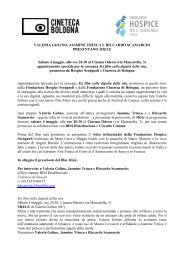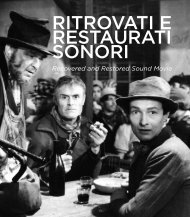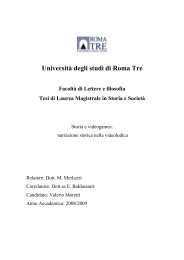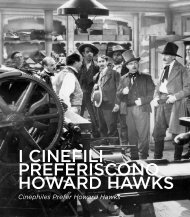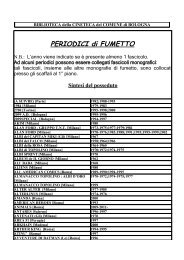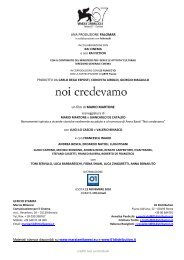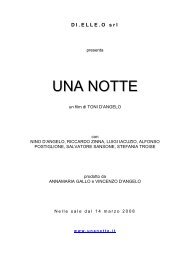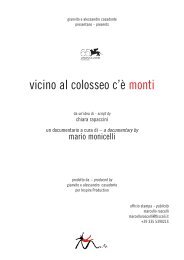Catalogo 1999 - Cineteca di Bologna
Catalogo 1999 - Cineteca di Bologna
Catalogo 1999 - Cineteca di Bologna
Create successful ePaper yourself
Turn your PDF publications into a flip-book with our unique Google optimized e-Paper software.
She was often called up to play the role of the rival woman. Her jet black eyes and hair created an<br />
unusual contrast with her tense and pale face, evoking a mysterious and ambiguous appearance.<br />
She made her debut in the beginning of the century at Berlin’s Deutsches Theater, and her acting career had been burgeoning<br />
on stage in the most important German theatres for at least ten years when Eugen Illés asked her to work for the screen. From<br />
1913 onward, and under the same <strong>di</strong>rector, Morena acted in a dozen films one after the other, often with Alexander von Antalffy<br />
as her partner who a few years later, having moved on to the other side of the camera, called her to act together with Emil<br />
Jannings in Wedekind’s Lulu. Also in 1917 she played in the first version of Tagebuch einer Verlorenen, <strong>di</strong>rected by Oswald with<br />
Conrad Veidt and Werner Krauss, which anticipated the project which a dozen years later Pabst took up again with Louise<br />
Brooks. Throughout the silent period, Morena was the lea<strong>di</strong>ng actress in four to five films a year, <strong>di</strong>rected by Wiene, Murnau<br />
(Der Gang in <strong>di</strong>e Nacht), Czerepy, Steinhoff, May (Das in<strong>di</strong>sche Grabmal), Franck, Froelich, Boese, Holger-Madsen, Pabst<br />
(Man spielt nicht mit der Liebe), Gaston Ravel.<br />
Sound cinema <strong>di</strong>d not stop her career, but moved her progressively away from the limelight. (Vittorio<br />
Martinelli)<br />
Io ho creato la donna <strong>di</strong> mondo e la femmina. I miei sforzi miravano costantemente a tenere separati i due mon<strong>di</strong> in modo netto.<br />
Conseguire il massimo dell’effetto con la massima economia <strong>di</strong> mezzi era il mio obiettivo artistico. La plasticità propria del film e<br />
le sue risorse, questa possibilità <strong>di</strong> dar vita alle mille, sottili sfumature del movimento (dalle quali risulta senza soluzioni <strong>di</strong><br />
continuità l’immagine del personaggio, in modo del tutto <strong>di</strong>verso che a teatro) è quanto maggiormente mi ha attratto nel cinema.<br />
(Erna Morena, in Hermann Treuner (Hg.), Filmkünstler. Wir über uns selbst, 1928)<br />
I created the stylish lady and the wench. It was always my aim to clearly outline the border between<br />
these two worlds. My artistic objective was to achieve the greatest effect with the least means. The<br />
three-<strong>di</strong>mensional aspect of film and its potential, to be able to shape those thousand fine nuances of<br />
movement (from which the character then emerges visually, quite complete and quite <strong>di</strong>fferent to the<br />
theatre), that is what most attracted me about film. (Erna Morena, in Hermann Treuner (Hg.),<br />
Filmkünstler. Wir über uns selbst, 1928)<br />
ore 14.45<br />
Presentazione del progetto: ITALIA TAGLIA / First Presentation of the Project: ITALY CUTS<br />
Rosanna Rummo, Direttore Generale del Dipartimento dello Spettacolo del Ministero per le Attività e i<br />
Beni Culturali<br />
Giuseppe Bertolucci, Presidente della <strong>Cineteca</strong> del Comune <strong>di</strong> <strong>Bologna</strong><br />
Vittorio Boarini, Direttore della <strong>Cineteca</strong> del Comune <strong>di</strong> <strong>Bologna</strong><br />
Andrea Marcotulli, Direttore generale ANICA<br />
Tatti Sanguinetti, Curatore del progetto<br />
annunciano l’avvio e le tappe del progetto.<br />
Tagli a sopresa / Choice of surprise cuts.<br />
ore 15.25<br />
Divine apparizioni / Divine apparitions - Erna Morena<br />
TASCHENDIEBE (I borsaioli / Germania, 1920). R.: Emil Justitz. In.: Erna Morena, Emil Mamelok,,<br />
Maria Zelenka, Ernst Wurmser, Hans Albers, Willi Kaiser-Heyl, Richard Georg, Margarete Kupfer,<br />
Fritz Sattler, Alexander Areuss, Hans Lindegg. 35mm. L.: 2098m. D.: 116’ a 16 f/s. Didascalie russe /<br />
Russian intertitles<br />
Da: Gosfilmofond of Russia



